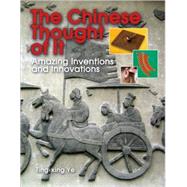
| Welcome | |
| Map | |
| Timeline | |
| Farming | |
| Working with Metal | |
| Transportation and Exploration | |
| Canals and Bridges | |
| Weapons and Warfare | |
| Paper and Printing | |
| Silk | |
| Everyday Innovations | |
| Food | |
| Health and Healing | |
| Games and Sporting | |
| China Today | |
| Further Reading | |
| Index | |
| Table of Contents provided by Publisher. All Rights Reserved. |
The New copy of this book will include any supplemental materials advertised. Please check the title of the book to determine if it should include any access cards, study guides, lab manuals, CDs, etc.
The Used, Rental and eBook copies of this book are not guaranteed to include any supplemental materials. Typically, only the book itself is included. This is true even if the title states it includes any access cards, study guides, lab manuals, CDs, etc.
Excerpt
Huan ying, Welcome
Qian-li-zhi-xing, shi-yu-zu-xia.
Even the longest journey begins with the first step.
I welcome you on this journey to discover the amazing inventions and innovations of ancient China. You probably guessed from my name that I am Chinese. I was born and raised in Shanghai, where I lived for many years before I came to Canada. When I was a kid, I went to school like you. I learned to read, write, and do arithmetic. Later on, I took on History, Geography, Science, and other subjects.
I studied English at Beijing University. My second language helped me understand the world better. After graduation, I worked as an English interpreter for many years. During that time I met many leaders from other countries, including members of the Canadian Parliament and the American Congress.
I thought I knew a lot about China's past and present. It wasn't until I sat down to write this book that I realized I had much more to learn. As I got deeper into my research, reading books and checking Internet resources, I grew more and more excited about my findings. I am glad I have the chance to share with you what I have learned. I hope this book will be the beginning of your own journey of discovery. Now, let's take the first step together.
China is the third largest country in the world, after Canada and Russia. In the north is a great plain. To the south are rivers, lakes, and lowlands. In the west are mountains. China's two great rivers, the Long River, or Yangtze, and the Yellow River are among the longest in the world.
Some of ancient China's famous inventions are still used today, in China and around the world. Many of them have been improved; many remain the same.
When I was a teenager, the Chinese government forced millions of people my age to go and live in the countryside. At sixteen, I was sent to work on a farm far from home. The main crop there was rice. Each spring we used iron plows pulled by water buffalo to turn up the hardened earth before the fields were flooded to make paddies. Later, I and other teenagers hand-planted rice seedlings in straight rows, following an ancient method I describe in this book. The grid we formed made weeding and harvesting a lot easier and more efficient.
On the farm, the wheelbarrow was one of our main transportation tools. We used it to haul bricks, bags of grain and fertilizer, and once even a newborn calf. I learned from experience that wheelbarrows with longer handles were easier to control and required less strength when pushing a heavy load. That was a good thing because I was a small and light young woman at that time. My farm-mates and I fondly called our wheelbarrows "wooden oxen." Apart from the iron plow and wheelbarrow, my research brought back even more memories: the type of yokes and harnesses placed on the farm animals, the hoes we used in the vegetable garden, and the herbal medicine we were given at the village clinic. All these things were invented by the ancient Chinese. All are still very useful.
I hope you will find your journey of discovery interesting. Enjoy your trip.